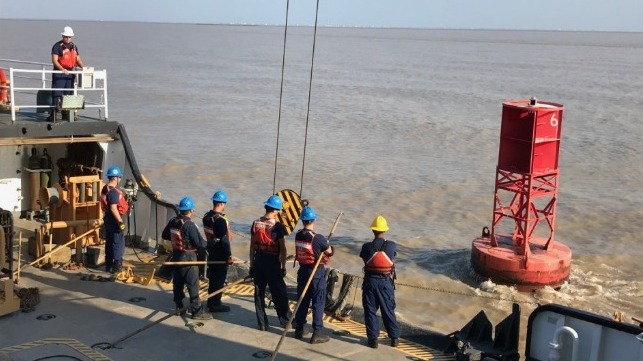Electronic ATON Helped Reopen Ports After 2017 Hurricanes

The U.S. Coast Guard was recently recognized by the International Association of Marine Aids to Navigation and Lighthouse Authorities (IALA) for its use of electronic Aids to Navigation (eATON) during the 2017 hurricane season. IALA's members selected the U.S. Coast Guard for its best practices award during its recent conference in Incheon, South Korea.
The U.S. Coast Guard maintains more than a quarter of the eATON in use around the world today. Using the Nationwide Automatic Identification System (AIS) network of shore-based towers, the service employs eATON to augment its everyday physical ATON constellation for mariners who can “see” eATON with an AIS receiver and electronic charting system or integrated radar. Besides hurricane preparation and response, eATON has also been successfully used to respond to high water events on the Mississippi river system and to supplement buoys in ice-covered waterways.
Following Hurricane Harvey, the Coast Guard established 13 eATON "markers" around Port Aransas, Texas. By temporarily using eATON to mark the buoys and beacons that were destroyed or damaged by the hurricane, the Coast Guard was able to reopen the port more quickly.
The eATON were broadcast over the Coast Guard’s Nationwide Automatic Identification System and could be used by any mariner with an AIS-equipped radar or electronic charting system. This ability to quickly and remotely mark the waterway contributed to the port opening several days ahead of schedule. As a backup, the Coast Guard also deployed a portable AIS system, giving it the ability to broadcast eATON in areas that Nationwide AIS does not cover.
Leveraging the lessons learned from Hurricane Harvey, the Coast Guard proactively established over 300 eATON around U.S. waterways in Hurricane Irma’s forecasted track prior to the storm. The eATON marked waterways from Tampa, Florida, to Key West, Florida, and up the eastern seaboard to Charleston, South Carolina, as well as around Puerto Rico.
Following the hurricanes, eATON provided a constant aid to navigation for mariners, including the buoy tenders and ATON teams that reconstituted the damaged physical ATON system.
U.S. Coast Guard ATON personnel serve on IALA committees and contribute to the organization’s work to ensure safety of navigation. During the conference, the United States was re-elected to the IALA Council, which is IALA’s governing body. “It is an honor and privilege to be a part of the leadership team that will lead IALA into the future,” said Capt. Mary Ellen Durley, the chief of the Office of Navigation Systems and the designated U.S. Councilor to IALA. “The maritime industry is going through a stage of rapid technological advances, and I look forward to IALA addressing these challenges."
The opinions expressed herein are the author's and not necessarily those of The Maritime Executive.
